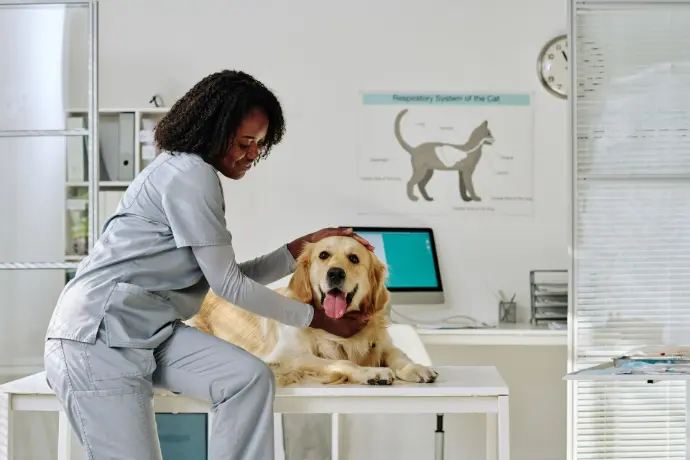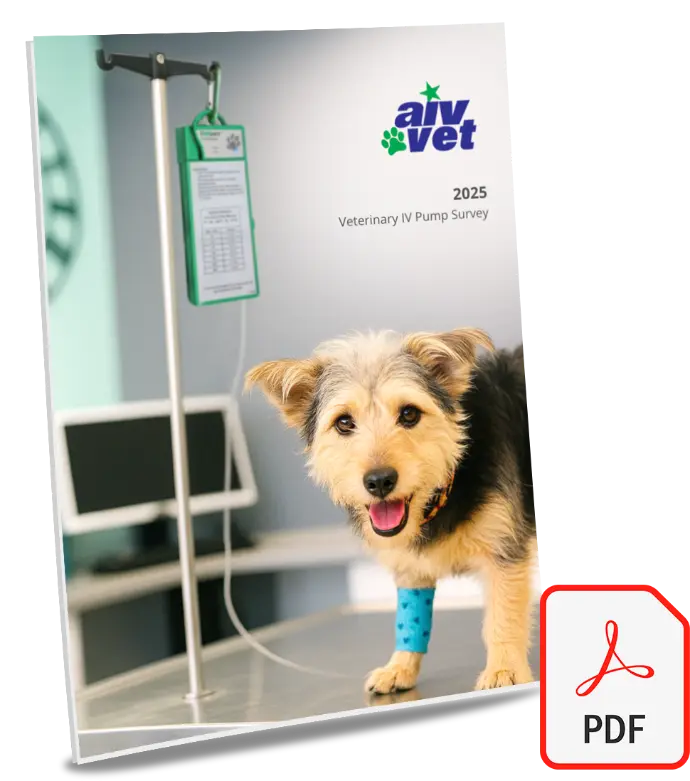Today, we’re going to approach your critical care equipment needs strategically.
A majority of veterinary practices, possibly including yours, haven't yet incorporated CRI pumps, syringe pumps, or fluid warmers into their care protocols.
In 2025 we completed the AIV-Vet veterinary IV pump survey, where we talked with more than 100 vets to understand their experiences with fluid delivery equipment. Our research found that 80% of veterinarians agree that infusion pump upgrades improve patient outcomes, yet strong cost concerns continue to be a barrier to adoption.
This presents both an operational challenge during complex cases and a strategic opportunity to differentiate your practice. Your team is likely managing with manual methods for fluid administration, but together we can envision a more efficient future.
Practice owners can find themselves in planning paralysis, unclear about the timing and scope of these investments until urgency forces reactive decisions. Developing a 5-year equipment plan gives your whole team a clear timeline, turning scattered "we need this now" purchases into a sensible roadmap that improves what your practice can do clinically while spreading costs in a way that matches how your practice is actually growing.
Why strategic equipment planning matters now
The veterinary landscape is evolving rapidly (maybe it always is, but with increasing acquisitions by large brands and burnout among practitioners growing, today feels unique). Client expectations for advanced care are also rising alongside increasing caseloads. This creates a handful of compelling reasons to approach critical care equipment planning methodically.
Reactive purchases often cost more in both immediate expenses and lost opportunities.
Equipment emergencies put stress on your entire team during already challenging cases.
Phased implementation allows controlled and calm training and integration into clinical workflows.
Budget predictability helps maintain healthy cash flow and prevents surprise capital expenditures.
Strategic acquisition enables you to slowly and thoughtfully search for the right equipment and price point, versus the panic of emergency purchases that need to solve a crisis right now.

Why strategic equipment planning matters now
Before developing your plan, it's important to understand where your practice stands relative to current standards of care. While many practices have invested heavily in diagnostic equipment like digital radiography, critical care delivery systems often remain overlooked despite their significant impact on patient outcomes.
| Equipment type | The reality in your current practice… | When you invest strategically in fluid delivery automation… |
| CRI pumps | Manual rate calculations and frequent adjustments by staff. | Precise medication delivery, reduced medication errors, consistent therapeutic levels. |
| Syringe pumps | Limited ability to deliver accurate volumes of critical medications without labor intensive manual work. | Accurate dosing, greater productivity for vet techs, improved safety margins for potent drugs. |
| Fluid warmers | Room temperature fluids contributing to hypothermia and recovery issues in surgical and critical patients. | Maintained core body temperature, faster recovery times, reduced anesthetic complications. |
This equipment gap directly affects how well patients recover, how much time your staff spends on manual tasks, and how many of what types of cases your practice can safely manage. As one vet in our survey noted, "When I deliver IV medications for post-operative care or administer precise antibiotic protocols, I set a flow rate and check it throughout the treatment. In emergency scenarios where rapid adjustments are needed, I tweak the rate in real time. My preventive maintenance program, which includes regular checklists and performance reviews, helps limit instrument-related errors across everyday procedures and more critical situations."
Building your 5-year critical care equipment plan
We've helped veterinary practices across the USA develop strategic equipment plans that balance clinical needs with financial realities.
Step 1 - Assess your current capabilities and limitations
Start by evaluating your practice's critical care capabilities honestly.
What types of cases do you currently refer that you could potentially manage with more equipment?
Where do staff members experience the most stress or inefficiency during critical cases?
Which manual processes create the highest risk of errors during emergency situations?
What equipment would have the most immediate positive impact on both patient care and team wellbeing?
This assessment helps prioritize equipment that addresses your most significant pain points first.
Step 2 - Align equipment with your practice growth goals
Your equipment plan should support your broader practice vision, so you can make moves today that compound in value for your practice down the road.
If expanding emergency services is a goal, prioritize multiple syringe pumps and warmers.
For practices focusing on geriatric care, precision medication delivery becomes essential and you might want to plan for something like a Baxter CRI pump.
If improving surgical outcomes is important, temperature management through veterinary iv fluid warmers offers significant benefits.
Practices looking to reduce staff burnout should prioritize equipment that automates time-consuming manual tasks, like a low maintenance veterinary syringe pump.
Step 3 - Create a phased implementation timeline
Rather than spending a heap of budget at once to buy every piece of equipment at once, develop a realistic timeline that spreads both costs and implementation. See below for an example with general costs (we can give you precise pricing to plan out if you contact us here).
| Year | Equipment focus | Approximate investment | Clinical impact |
| Year 1 | 2 syringe pumps for critical medication delivery | $1,000-2,500 | Immediate improvement in critical drug administration safety. |
| Year 2 | 2 fluid warmers for surgical and critical patients | $500 | Reduced recovery complications, improved surgical outcomes. |
| Year 3 | 2 additional syringe pumps | $1,000-2,500 | Expanded capacity for complex cases and concurrent treatments |
| Year 4 | 2 patient ready CRI pumps for intensive care cases | $2,000-3,000 | Enhanced capability for managing critical hospitalized patients |
| Year 5 | Additional fluid warmer and setting aside maintenance budget for future service of year 1 equipment | $1,000-1,500 | Completed critical care equipment ecosystem with redundancy |
This phased approach allows your team to fully integrate each piece of equipment into clinical workflows before adding more complexity.
Step 4 - Commit to a financial strategy
With a clear equipment roadmap established, you can implement practical budgeting hacks that will help make every investment easy.
Create a dedicated equipment fund with monthly automatic transfers - even small regular amounts add up significantly over time.
Allocate a specific percentage of revenue (many practices use 2-3%) each month toward future equipment needs.
Track the funds separately in your accounting system so they’re never absorbed into general operating expenses.
Revisit your fee schedule annually - small adjustments to high-volume services can fill in your dedicated equipment funding without major client impact (round your cost of nail trims up to the nearest tens of dollars and you pay for your upgrades every year)
Schedule equipment purchases strategically around your practice's cash flow cycles, typically targeting periods after high-revenue months.
Look for promotions, trade show specials, and end-of-year deals when making planned purchases.
Explore potential tax advantages with your accountant, as equipment investments often qualify for beneficial treatment when properly planned.
We've found that practices with dedicated monthly equipment savings plans typically implement their equipment goals 2-3 years faster, and with less pain, than those making reactive purchases based on immediate needs or emergencies. This methodical approach removes the financial stress of unexpected large purchases.
Step 5 - Measure and adjust for the future
Once implementation begins, track both clinical and financial outcomes.
Monitor cases that could previously only be managed with referral.
Track staff time savings from automated processes.
Calculate medication waste reduction from precision delivery systems.
Document client satisfaction with enhanced care capabilities.
Learn from others’ mistakes to avoid common planning pitfalls
Through our work with thousands of practices, we've identified several common mistakes in equipment planning.
Underestimating training needs - budget time for proper staff education with each new piece of equipment.
Focusing solely on purchase price rather than total cost of ownership including consumables, availability of parts, expected maintenance and repair costs, and quick service availability.
Neglecting to consider facility requirements like electrical capacity or counter space.
Attempting too much change simultaneously, overwhelming staff with new protocols.
Failing to communicate the strategic vision to the entire team, reducing buy-in.
Moving from plan to action
A practical equipment plan turns better critical care from "something we should do someday" into "something we do." Planning these investments methodically gives everyone clear benefits - patients get more consistent care, your team faces less stress during emergencies, and your practice avoids financial surprises that hurt your profitability.
We've helped practices like yours make this change successfully, providing both the equipment and hands-on support needed to improve patient care and staff satisfaction/retention. We can build customized equipment plans that align with the goals you have for your practice and those important financial parameters.
Ready to start developing your equipment investment roadmap? Get in touch with us for a chat today.

